Con and Barb Campbell arrived at Bachelor Lake, Québec, in mid-August 1950 to manage the Gold Belt Air Service float plane base there. For the first few weeks, they worked from dawn to dusk getting the camp in order, and settling into the routine of refuelling company airplanes, operating the two-way radio, providing weather reports, and accommodating aircraft, pilots and passengers for overnight stays as needed. At last, they had time to relax and enjoy the natural world around them, as Barbara describes here.
This is the fourth in a series of excerpts from Barbara’s journal, “Bachelor Lake Daze,” published here with the kind permission of Dr. Sandra Campbell and Con Campbell, Jr. To view all posts from “Bachelor Lake Daze,” click on the Gold Belt Air Service category below the main title at the top of the page.
A short bio of Barbara Van Orden Campbell can be found here: http://wp.me/P790K9-6J
Our first few weeks had been crammed with activity. Winning the battle with the two-way radio had been a major victory. We could now keep in touch fairly reliably with the Outside World. A large dose of elbow grease had converted the chaotic state of the cabins that greeted us on arrival with order and cleanliness. The business of running the Bachelor Lake base for Gold Belt Air Service of Rouyn, Québec, had become a familiar routine and we could finally spend more time enjoying the world around us.
In brief sorties away from the radio in the shortening dusk, we paddled down the lake trolling for pike. Although of good size they were muddy tasting and soft of flesh, and about as exhilarating to hook as an old boot. As the lake water chilled with the approach of Autumn, they became more palatable. There were pickerel and whitefish, too, and even sturgeon, though we never saw any from the canoe, for which I was grateful for they grew to giant proportions and are a most sinister looking device.
One day when I was flying with Gold Belt pilot Bob Birkett, as we approached Bachelor Lake at low altitude and circled for a landing, he pointed downward to the water on his side of the plane and heeled the plane so I could see across him to where he gestured to a long, smooth, dark shape just below the surface.

Canada’s largest freshwater fish, the lake sturgeon can weigh up to 180 kilograms and grow to more than 2 meters in length. The sturgeon is considered a threatened species. Photo: Barb Mullally.
“Overturned canoe?” I shouted, suddenly filled with anxiety for Con’s safety. “Sturgeon sunning himself,” Bob replied. And so it must have been, for we taxied slowly and cautiously by the spot and there was sign of neither log nor beast.
The woods were beautiful now that the flies were diminishing in number. The tall spruce was the boss near the lake, intermingled with cedar and birch but as we followed the bush trail behind the camp up the long, gentle grade we passed through a large grove of white birch and poplar. It was thickly populated with rabbits, squirrels and the most trusting partridge families in creation. We often saw the tracks of moose and bear, and it was not unusual to hear the high, quavering howl of a wolf, the most primitive of sounds and one which never failed to make me break out in a rash of goose bumps.
The lake was the home of a pair of loons who seemed to be always in the midst of divorce proceedings. They shouted insults at each other from opposite sides of the lake the whole day long but as twilight descended, the approach of night seemed to make each see the intrinsic worth of the other and they fell into a panic that perhaps today they had gone too far with the insults. Tearfully and tenderly each called apologies until they met joyously in the middle of the lake. They swam off arm in arm into the sunset, laughing their ghoulish laugh.
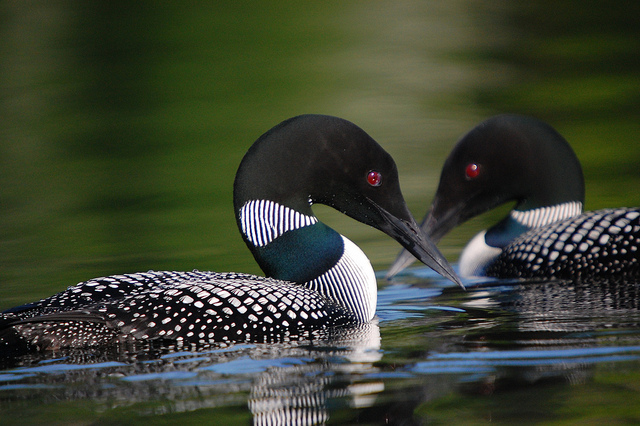
Did you know that 95 per cent of the world’s Common Loons breed in Canada? Loons are water birds with prodigious diving skills, catching the fish they eat underwater. To fly, they flap their wings and run on the water’s surface until airborne. They can achieve flight speeds of 130 km an hour. Loons are monogamous, and a pair will return to the same nesting area every year. Excellent descriptions and sound clips available at http://www.audubon.org/field-guide/bird/common-loon Photo: Gary J. Wege, U.S. Fish and Wildlife Service.
I practiced imitating their cry by blowing through my cupped hands while waggling my fingers strategically. One day, as Con and I were paddling down the bay one of the loons came hurtling along, passing only a dozen yards above our heads. I dropped my paddle across the gunwales, cupped my hands and blew one call, tremulous with passion. The bird reversed his engines, jammed on his brakes so hard we could almost hear them squeal, and wheeled back for a closer look. Seeing nothing more inspiring than two people laughing like loons the disillusioned fowl departed in a high dudgeon.
Across our little bay was a point of land which marked the mouth of a river. Upon this point was a tall, dead tree, wherein nested an osprey, or fish eagle. It was fascinating to watch that chap at work. He would fly a neat patrol pattern at an unvarying height up and down the bay searching for fish. Suddenly he would pause and with wings churning wildly he would hang stationary in mid-air until he had his sights fixed on his quarry below. Then, like a feathered anvil, he would plummet into the water. A great thrashing and floundering would follow, as he appeared and disappeared, until at last his two mighty wings would break the surface and with a great heave, he would take to the air with a silvery fish flopping in his talons. I loved to watch this performance but it usually gave me a charley horse in both arms as I strove to help him get airborne.
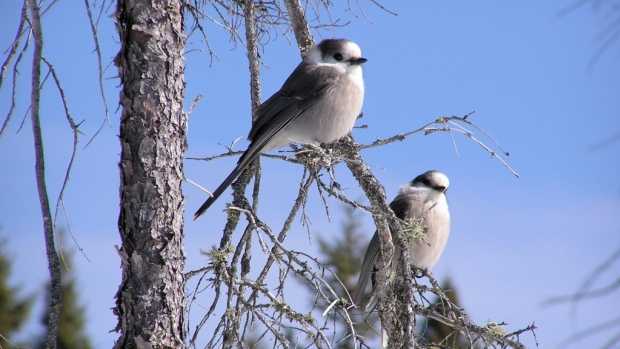
The Canada Jay or Whiskey Jack was unofficially named as Canada’s national bird by the Royal Canadian Geographic Society in 2016. Slightly smaller than a Blue Jay, the Whiskey Jack is found in the boreal forests of every Canadian province and territory. Photo: Dan Strickland.
There were, of course, numerous styles of smaller birds: flocks of bustling chickadees, red crossbills, ravens, and that omnipresent and engaging rogue – the Canada Jay. When winter closed in, we constructed a bird feeding station from the top of a bushel basket that had been used for apples. This was promptly pre-empted by the jays, who kept it picked clean. They were very bossy. When their meals were not served on time they pounded the table and screamed for service in a most unseemly manner. They learned to come when called and, perched on our shoulder or head, took crusts held between our lips. Where they spent their time when not bullying us for food mystified me. There would be no feather in sight for hours as we passed in and out of the cabin, but just let one of us take a step toward the feeder with a pan of scraps and immediately we would be smothered in a swirl of grey- and white-feathered gluttons.
The Arrival of the Pups
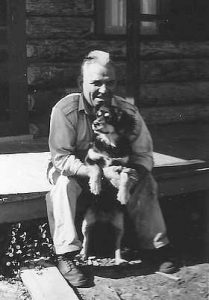
Alphonse Truchon and his dog Poupoune visiting the Campbells at Bachelor Lake. Photo: Courtesy of Con Campbell Jr.
Alf had a dog of which we were all very fond. She was a long-eared, silky-haired, worried looking bitch of some complicated spaniel lineage. Her long, fine hair was glossy black while her feet and belly were a bright, golden brown. Over each eye was a small patch of this same light color, giving her face a remarkable animation. She could speak volumes with one lift of a golden eyebrow and often told us off quite thoroughly in this manner. Alf called her “Poune” which he said was a shortened form of a French term of endearment: “Poupoune.” She was well trained and obedient but seemed always to be struggling under some unsupportable load of responsibility and we seldom saw her smile.
The spring before we arrived she had given birth to a litter of pups of some mystic origin. I don’t know what happened to the rest of the litter, but two of the females lived at the Dome camp where they had been adopted. When Fall came and the camp closed down, the two little waifs were left homeless. The pair followed the tractor-loads down from Dome to the lake bewildered at the upheaval. When we heard they were to be shot because no one wanted them, we leaped to the rescue and took them in.
Nameless when we acquired them, the pups were soon named after the two Norseman aircraft, CF-BSE and CF-PAA. The chubby number became BSE and her sister answered to PAA. It made for some confusion at first, with both planes and canines having the same call letters. I quickly stopped rushing out the door, my mouth agape, when Con shouted through the window that PAA had treed a partridge, or that he could hear BSE taking off from Lichen Lake.
Six Ounces of Fury
Just before freeze-up that first year we received an unexpected gift from a friend in Noranda. When Gordon came up the path after landing the plane that day, he carried at arm’s length a small, dripping cardboard carton which emitted yowls of rage and what looked to be sixteen paws poking through the eight air holes.
Thrusting it into my surprised hands he said, “Here! For God’s sake, take this thing! It’s been driving the whole Gold Belt organization nuts for the past two days!”
Puzzled, I set the box gingerly on the end of the table and opened it. Like a jack-in-a-box, out shot six ounces of fury which landed beside the box and danced sideways the full length of the table, its tiny face contorted with rage and the three-inch tail bushed out like a bottle brush. Tiger-striped and owl-eyed, she presented a miniature picture of towering indignation.
I had the incredibly poor taste to laugh at this spectacle and was rewarded by a display of surgical-looking fangs and a jungle noise like a hot tack quenched in a thimble of water.
Con walked in on this tableau. “Jesus!” he said in an awestruck whisper.
“No,” corrected Gordon, “It’s a kitten. And don’t tell me you don’t want her, because I’m not flying back alone with that banshee in the plane. She squalled all the way from Rouyn. Every time I throttled back, she’d be screaming as if she had her tail caught in the cargo door. Besides, I hate cats. Now, where’s some of that good coffee?”
It took a heap of lovin’ to bring that cat into the Mutual Admiration Society into which she had been delivered. The plane trip had apparently been a traumatic experience for her and for many weeks she literally climbed the walls each time a plane came in. But win her over we finally did, although she was a one-family cat and all other human types could just plain go to hell as far as she was concerned. We called her “Roger-Roger” in the radio patois, but this was soon shortened to “Rog.”
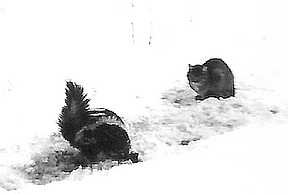
Roger-Roger with with the semi-tame skunk Tabu, named after the famous perfume. Photo: Courtesy of Con Campbell Jr.
A skunk soon joined the menagerie, though not as a house pet. Nicknamed “Tabu” in homage to its pungent perfume, the skunk developed an understanding with Rog that diplomatic relations could be maintained if both parties respected each other’s personal space.
Roger grew into a most lethal-looking creature, streamlined and deadly, and every inch a cat. It used to puzzle Con, who had not cut his teeth on the species since infancy as I had, that she could be so absolutely cat-like in every way with no other cat to copy from. She practiced her cat craft constantly and never made a move out of character.
The dogs were at first bewildered by this small whirlwind that slashed them eight times across the nose before they could fall over backwards out of range. But the three soon became good friends and slept all in a heap under the stove. As Roger grew older she treated the dogs as if they were her none-too-bright offspring and worried and fussed over them when they came in dripping from a run in the rain. Holding a wet dog’s head clamped firmly in her arms she would lick it dry, giving special care to both sodden ears, scolding and nattering as she shifted her motherly grip.
If she loved our dogs and treated them like her own children, she treated poor Poune like a step-child. When Alf came over in the evenings to play cribbage, Poune huddled close to her master’s feet whimpering in terror at the apparition staring at her from under the stove. Roger’s unnerving stare never wavered from Poune’s stricken face as the hours passed. Occasionally Poune’s muscles would become cramped from staying so long in one position and she would cautiously stretch a leg to ease it. Instantly Roger was upon her, yelling like seventy-seven devils and turning a quiet card game into a shambles as our two dogs dashed into the fray to rescue they knew not whom from they knew not what.
Pleased as punch, Roger would then stretch luxuriously before announcing in a self-satisfied manner, “Well, that’s enough excitement for today. It’s time for a really good sleep now.”
Sad End to the Pups
Before the lake froze over, poor little BSE met with an unladylike end in the jaws of a wolf. On a run back up to the Dome property with PAA to visit their old haunts, BSE was cornered by wolves and devoured forthwith. We were informed of the gruesome occurrence by a couple of men who had stayed behind to batten down the Dome camp for the winter. We were very sorry to lose her – she was my favourite, being the more affectionate and gentle of the two. A couple of years later, PAA was killed by bears, also at the Dome property. Life in the bush can be harsh at times.
Con Campbell Jr. provides a postscript to his mother’s story.
Swatting at Crows
Roger-Roger the cat had a favourite game. She would sit on a stump near the cabin and the local crows would dive-bomb her as she swatted at them with all her might. Good fun for all.
Dad decided to get rid of that stump. So he planted a stick of dynamite under the stump, lit a fuse, and all retired to a safe distance to observe results. Just before zero hour, Dad spots Roger-Roger sitting on the stump happily swatting at the crows with not a care in the world.
Dad runs outside, grabs a hammer, and launches it at the cat yelling at the top of his lungs. Roger-Roger departs the scene at high speed towards the bush. BIG Boom.
Roger-Roger made herself scarce for a couple of days. When she reappeared, she chose a new stump and the games with the crows resumed. Dad never tried the dynamite trick again.
Con Campbell Jr. has been flying helicopters commercially for the past 40 years. He got his commercial pilot’s licence in 1974, and flew Otters, Beavers and Cessna 185s until he qualified as a helicopter pilot in 1978.

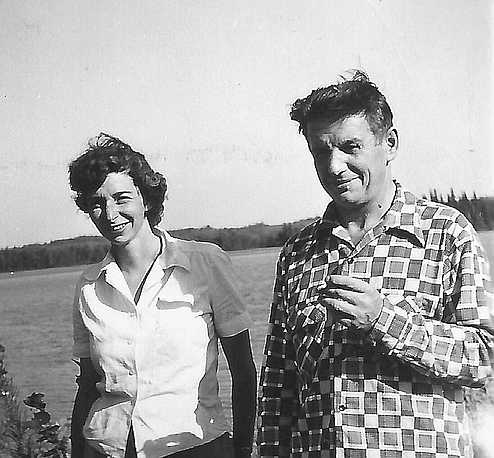

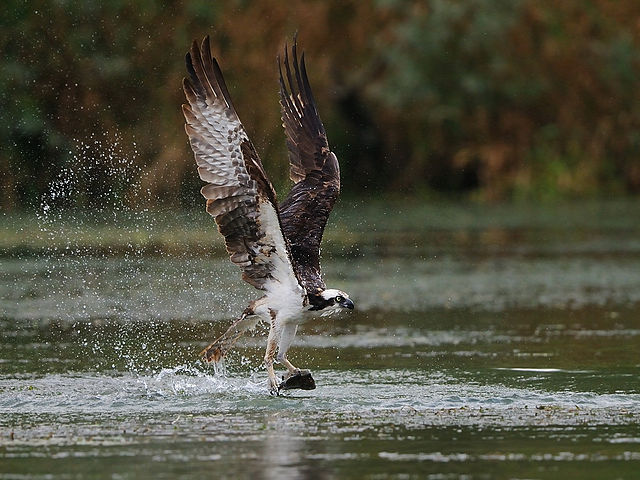
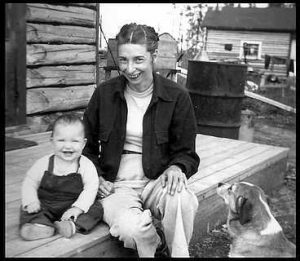
Finely written memories of a summer idyll with quirky pets and northern wildlife.
And two Norsemans. Enjoyed that, looking forward to more from her journal.
So happy to see another chapter published.
We need to publish the first chapters as to how they got there.
There will be a couple more installments to take us to the end of your mother’s journal, and then I promise we will get to the hilarious first part of her tale. She sure could write – and she must have been a fascinating person! Diana
Lovely, Diana.. Many thanks to you and Con. Sandy